Aeritalia G.222
| G.222 C-27A Spartan | |
|---|---|

| |
| A US Air Force C-27A Spartan out of Howard AFB, Panama | |
| Role | Military transport aircraft |
| Manufacturer | Fiat/Aeritalia/Alenia Aeronautica |
| First flight | 18 July 1970 |
| Introduction | April 1978 |
| Retired | 2012 (Afghan Air Force) |
| Status | In service |
| Primary users | Italian Air Force(historical) Nigerian Air Force Argentine Army Aviation(historical) |
| Produced | 1970–1993[1] |
| Number built | 111[1] |
| Developed into | Alenia C-27J Spartan |
TheAeritalia G.222(formerlyFiat Aviazione,laterAlenia Aeronautica) is a medium-sizedSTOLmilitary transport aircraft.
It was developed to meet aNATOBasic Military Requirement 4;accordingly, it was originally designed with lift engines for aV/STOLcapability, but these were never fitted to production aircraft. No wider NATO production contact were emerged, butItalywas keen to support its homegrown transport aircraft and issued an order for it in a more conventional configuration. Following its introduction toItalian Air Forceservice in April 1978, the type soon proved itself to be capable for conducting operations from compact and austere airstrips, particularly humanitarian missions.
Various export customers emerged for the type during the 1980s and 1990s.Libyanefforts to purchase 20 G.222s were initially vetoed byUnited States;Libya later procured a version of the aircraft without US-made equipment present instead. The United States purchased 10 G.222s in the 1990s, designating the typeC-27A Spartan.[2][3]During the 2000s, as the Italian Air Force withdrew their original G.222s due to their advancing age, these aircraft were commonly refurbished and subsequently sold onto other nations; via this approach, several G.222s were dispatched to Afghanistan during theWar in Afghanistan.
A modernised variant, theAlenia C-27J Spartan,has been developed during the early 21st century. While it retains many aspects of the original aircraft, the C-27J adopts the same engines and many of the systems used on the largerLockheed Martin C-130J Super Hercules.Several G.222 operators, including the Italian Air Force, have opted to retire their fleets in favour of new-built C-27Js.
Development[edit]
Origins[edit]
In 1962, NATO issued a specification for aV/STOLtransport aircraft (NATO Basic Military Requirement 4), capable of supporting dispersed V/STOL fighters. Fiat's design team, led by Giuseppe Gabrielli, produced a design to meet this requirement, designatedG.222;it was to be powered by twoRolls-Royce Dartturbopropengines and with six to eightRolls-Royce RB162lift engines to give VTOL capability.[4]According to Aeritalia, the G.222 designation is derived from the first letter of the aircraft's chief designer; the first '2' referring to the twin-engine arrangement, and the final '22' referring to the revisedNATO Basic Military Requirement 22to which it had been submitted.[5]
None of the submissions resulted in a production contract; however theItalian Air Force(AMI), who was at the time seeking a replacement for theFairchild C-119 Flying Boxcar,felt that theFiat Aviazioneproposal had merit, and placed an order for two prototypes and a ground-test airframe in 1968.[6][7]The G.222 was substantially redeveloped from the NATO submission, the V/STOL lift engines having been omitted completely and the conventional Dart engines replaced by a pair ofGeneral Electric T64s;[6]the twin-boom tail featured on the V/STOL concept was also eliminated and replaced by a more conventional single tail configuration; subsequently the new aircraft had no V/STOL capability but retained considerable short take-off/landing (STOL) performance.[8]
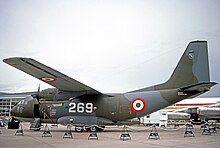
On 18 July 1970, the first prototype performed the aircraft'smaiden flightwith test pilotVittorio Sanseverinoat the controls. By late April 1971, the prototype had reportedly conducted a total of 22 flights and accumulated 50 hours of flight time, during which its performance was claimed to have been highly close to predictions.[9]In December 1971, the Italian Air Force, who had placed a provisional order for the developing type, formally began evaluating the G.222 and the performance of the two prototypes then in service. Following a successful testing period, the AMI contract for 44 aircraft was issued toAeritalia(of which Fiat Aviazione had since become a part).[10]In December 1975, the first production aircraft conducted its first flight.[7]In April 1978, this same aircraft formally entered service with the AMI.[11]Following on from its introduction by the AMI, the G.222 was procured as a tactical transport aircraft by various international customers, includingArgentina,Nigeria,Somalia,VenezuelaandThailand.[12]
In December 1978, Aeritalia elected to transfer final assembly of the G.222 fromTurintoNaples,at which point a total of 44 firm orders had been obtained for the type and one aircraft per month was being manufactured.[13]Manufacturing of the G.222 was broken down into various companies; construction of the fuselage was performed at Naples, the center-section of the wing was produced byPiaggio,the wing panels were made byMacchi,the tail surfaces were built bySIAI-Marchetti,the engine nacelles by IAM, and the T64 engines werelicense-manufacturedbyAlfa RomeoandFiat.[14]
Further development[edit]
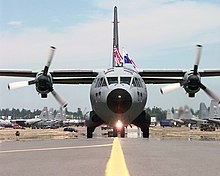
In 1977,Libyasought the purchase of 20 G.222s; this was vetoed by theU.S. Government,who had imposed an embargo on military arms and equipment to Libya, which included the G.222's T64 engines. To get around this restriction, Aeritalia developed a version of the G.222 powered by theRolls-Royce Tyneengine and other US supplied equipment was replaced by European equivalents; the more powerful Tyne engine also reportedly gave this variant superior "hot and high" performance.[15]The provision of alternative powerplants was viewed by Aeritalia as a measure to widen the overall appeal of the G.222; the Tyne engine also reportedly possessed greater growth potential than the T64 engine.[7]In May 1980, the first G.222 equipped with the Tyne engine performed itsmaiden flight.[7]Libya placed an order for 20 Tyne-powered aircraft instead, with deliveries commencing from 1980.[1][7]
In order to extend the effective operational lifespan of the type, some operators have carried out extensive upgrade programs of the G.222. In the aftermath of Italianhumanitarianmissions inBosniaandSomalia,in 1996 the AMI began undertaking a major update program on their G.222 fleet; modifications include cockpit lighting changes for compatibility withNight Vision Gogglesto enable night operations, increasing the aircraft's self-defense capabilities, new communications and navigation systems, and the removal of obsolete equipment.[12]In July 2005, theNigerian Air Forcesigned a $74.5 million contract with Alenia Aeronautica for the refurbishment of a total of five G.222s, as well as the purchase of a retired AMI G.222.[16]
In 1990, theUnited States Air Forceselected the G.222 as the basis of a "Rapid-Response Intra-Theater Airlifter" (RRITA). Operated under the designationC-27A Spartan,ten G.222s were purchased and underwent avionics upgrades byChrysler Aerospace.These aircraft were stationed atHoward AFB,Panama.[17]The USAF would later dispose of their C-27A fleet, partly due to shifting priorities between the Army and the Air Force and partly because of the impending introduction of a newer variant, theAlenia C-27J Spartan.[18]
Design[edit]

The G.222 is a twinturboprop-engine tactical military transport aircraft, and is designed to be capable of transporting equipment or troops in combat zones and operating with minimal ground support.[12]Early production aircraft were exclusively fitted with theGeneral Electric T64-GE-P4Dturbopropengine, thelicence-builtRolls-Royce Tynewas made available as an alternative powerplant for the type from 1980 onwards, while theAllison T56was another proposed powerplant for the type.[7][9]Due to features such as double-slotted flaps, stacked brakes, and reversible propellers,[19]the G.222 has excellent short landing capabilities and is able to land in as little as 1,800 feet.[20]It was designed to be integrated with the larger, commonplaceLockheed C-130 Hercules.[5]
The G.222's cargo deck can carry up to 9,000 kg (19,840 lb) of cargo, or alternatively up to 53 troops, or 32 paratroopers, or a maximum of 36 stretchers with six attending medics in amedevaccapacity.[14][20][11]The cargo deck has a large rear ramp, allowing the loading ofpalletised goodsand vehicles, as well as sliding doors on either side of the fuselage, which are capable of being used to deployparatroopers.[21]Various pallet-based special mission equipment could be readily installed to enhance the aircraft's capabilities for diverse roles such asVIPtransport,maritime patrol,aerial firefighting,and calibration functions; this equipment could also be removed quickly in order for aircraft to be returned to conventional transport missions.[14]To easily facilitate the loading of a wide range of cargos, the height of the landing gear can be manually controlled.[22]
In part due to the austere maintenance requirements of the G.222 and its capability of operating from short unprepared airstrips in remote regions, it has seen heavy use for performing various humanitarian missions across Africa, East Asia, Europe and Central America.[5][12]
The cockpit provides excellent external visibility for pilots, most of the key controls are centrally placed between the two pilots, enabling the aircraft to be flown by a single pilot under certain circumstances.[9][12]The standard G.222 is equipped with various avionics, such as a nose-mountedDoppler radar,navigational computers, radio systems, and aRockwell Collins-builtautopilot.[14]Electronic receiver equipment and up to ten control consoles were installed upon a number of G.222s for performingelectronic reconnaissancemissions.[14]Some aircraft were fitted withaerial refuellingprobesand associated equipment.[22]Some Italian G.222s have been equipped with a self-protection suite, which uses multiple forms of sensors to warn against identified threats, this suite also includes several countermeasures such aschaffandflaredispensers.[22]
Operational history[edit]

In 1978, the 98th Group of the 46th Transport Air Wing became the first squadron of the Italian Air Force to receive the G.222. The type was promptly placed into a support capacity, not only to the Italian Air force but also for humanitarian and civil protection.[5]
The G.222 has seen considerable service in air relief and military supply operations. From 1979 onwards, Italy, along with other Western nations, provided considerable military aid toSomalia,part of the Italian contribution was four G.222s.[23]In 1982, threeEjército ArgentinoG.222s were operational during theFalklands War,and may have participated in a logistical capacity.[24]In 1983, a single Italian Air Force G.222 was outfitted for fire suppression duties, alongside an existing C-130 in the same role.[25]
On 3 September 1992, anItalian Air Force(Aeronautica Militare Italiana) G.222 was shot down when approaching Sarajevo airfield while conducting a United Nations relief mission. It crashed 18 miles (29 km) from the airfield; a NATO rescue mission was aborted when 2 USMC CH-53 helicopters came under small arms fire. The cause of the crash was determined to be a surface-to-air missile, but it was not clear who shot it. Everyone on board – four Italian crew members and four French passengers – died in the crash.[26][27][28]
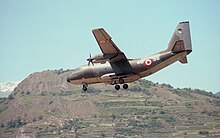
In November 1999, the Italian Air Force placed an initial order for twelve new-build aircraft of an upgraded G.222 derivative, designated as the C-27J, as a replacement for their existing G.222s.[29][30]In December 2002, Alenia Aermacchi agreed to purchase a total of 39 G.222s that had been previously operated by the Italian Air Forces under a trade-in arrangement as part of the agreed C-27J purchase.[31]In 2005, the Italian Air Force started the phased retirement of their G.222 fleet.[32][33]Several of the former Italian Air Force G.222s have been refurbished to operational conditions and resold by Alenia Aermacchi, theNigerian Air Forcebecame the first customer for these refurbished aircraft.[5][31]
In September 2008, Alenia North America was awarded a USAF contract to upgrade and refurbish 18 G.222s, to be transferred to and used by theAfghan Air Force.Ballistic protection, adaptations for serving in the conditions of Afghanistan, and many new avionics systems, including a digital auto-pilot, were installed; two aircraft were also configured for VIP transport duties.[32][34][35]On 28 April 2010, the first two of the Afghan Air Force's recently delivered G.222s made their first public display during theMujahideen Victory Day.[36]In January 2013, the USAF decided not to renew the support contract for the Afghan fleet due to claimed serviceability issues and operational difficulties; Alenia responded, stating that the fleet was exceeding the requirements laid out by the USAF, with 10–12 aircraft available for operations against the requirement for six.[37]
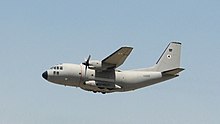
The 16 G.222s delivered to Afghanistan were scrapped in the summer of 2014 by theDefense Logistics Agency.[38]After the U.S. spent $486 million to buy 20 C-27As, 16 were sold as scrap to an Afghan construction company for about $32,000; the planes were reportedly scrapped "to minimize impact on drawdown of U.S. forces in Afghanistan." The four remaining aircraft are stored atRamstein Air Base,Germany, with the U.S. seeking other interested buyers. From January to September 2012, the Afghan C-27A fleet flew only 234 out of 4,500 required hours.[39]The C-17A fleet had been procured for their keep attributes to enable them to operate in Afghanistan terrain, they were former Italian G.222. However, they ended up being replaced by C-130H after maintenance difficulties.[40]
Variants[edit]

- G.222TCM
- Initial designation, two prototypes for the Italian Air Force[1]
- G.222A
- Standard transport version for the Italian Air Force
- G.222RM
- (Radiomisura- "radio measurements" )- radio/radar calibration aircraft
- G.222SAA
- (Sistema Aeronautico Antincendio- "aeronautical fire-fighting system" ) - fire-fighter equipped for dumping water or fire retardant chemicals. Four built for Italian Air Force.
- G.222T
- Version powered by theRolls-Royce Tynefor theLibyan Air Force.Sometimes designatedG.222L.[1]
- G.222VS
- (Versione Speciale- "special version" )ECMversion - two built for Italian Air Force. Sometimes designatedG.222GE.[1]
- C-27A Spartan
- Ten G.222s purchased for theUnited States Air Force.[1]
- C-27J Spartan
- SeeAlenia C-27J Spartan.
Operators[edit]
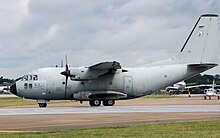

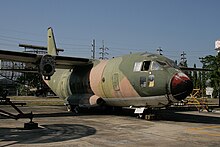
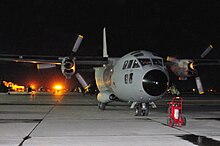
Current operators
- There are no known current operators (March 2024)
Former operators
- Afghan Air Forcehas received several former Italian Air Force G.222s under a USAF contract.[41]Following upgrades by Alenia, deliveries began in 2009. By December 2012, 16 aircraft had been delivered; the USAF canceled the contract then because of lack of maintenance support from Alenia[37][42]and scrapped them in summer of 2014.[38]
- Argentine Army Aviationhad 3 aircraft.[43]All retired as of December 2015.[44]
- Italian Air Forceoperated 56 aircraft (44 G.222A, 4 G.222RM, 4 G.222SAA, 2 G.222TCM and 2 G.222VS). Officially retired in September 2005, but at least 1 G.222VS aircraft remains operational.[45][46]
- Libyan Air Forceoperated 20 aircraft.[7]By 2004, these had all reportedly been sold to a private company.[47]
- Nigerian Air Forceoperated a total of 6 aircraft, all now stored.[48]
- Royal Thai Air Forceoperated 6 aircraft; retired as of 2010.[49]
- Somali Air Corpsreceived 4-6 aircraft.[50]
- Tunisian Air Forceordered 5 aircraft never delivered.[51]
- Dubaihad 1 aircraft (former operator).[citation needed]
- United States Air Forceoperated 10 C-27A (1990–99)[citation needed]
- US Department of Statehas 4 ex-USAF C-27As for transport in support of counter-narcotics activities in South America, primarily Colombia.[citation needed]
- Venezuelan Air Force- 6 aircraft[citation needed]
- Venezuelan Army- 2 aircraft[citation needed]
Specifications (G.222)[edit]
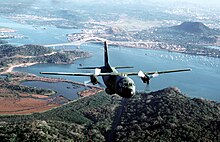

Data fromJane's All The World's Aircraft 1985–86.[52]
General characteristics
- Crew:3 + 1 loadmaster / jumpmaster
- Capacity:53 fully-equipped troops / 40 fully-equipped paratroops / 9,000 kg (20,000 lb) max. payload
- Length:22.7 m (74 ft 6 in)
- Wingspan:28.7 m (94 ft 2 in)
- Height:9.8 m (32 ft 2 in)
- Aspect ratio:9.15:1
- Airfoil:NACA 64A315.2[53][clarification needed]
- Empty weight:14,590 kg (32,165 lb)
- Max takeoff weight:28,000 kg (61,729 lb)
- Fuel capacity:12,000 L (3,200 US gal; 2,600 imp gal) in four integral wing tanks
- Powerplant:2 ×General Electric T64-GE-P4Dturbopropengines, 2,535 kW (3,399 hp) each at ISA + 25 °C (77 °F)
- Propellers:3-bladedHamilton Standard63E60-27, 4.42 m (14 ft 6 in) diameter constant-speed fully reversilble-pitch constant-speed propellers
Performance
- Maximum speed:540 km/h (340 mph, 290 kn) at 4,575 m (15,010 ft) at Max TO weight
- Cruise speed:439 km/h (273 mph, 237 kn) at 6,000 m (20,000 ft) at Max TO weight
- Airdrop speed:204–259 km/h (127–161 mph; 110–140 kn) (paratroops and cargo)
- Stall speed:155 km/h (96 mph, 84 kn) flaps and landing speed down
- Range:1,371 km (852 mi, 740 nmi) with max. payload at optimum cruising speed and height
- Ferry range:4,633 km (2,879 mi, 2,502 nmi) with maximum fuel
- Service ceiling:7,620 m (25,000 ft)
- Service ceiling, one engine out:5,000 m (16,000 ft)
- Rate of climb:8.667 m/s (1,706.1 ft/min)
- Time to altitude:4,500 m (14,800 ft) 8 minutes 35 seconds
- Wing loading:341.5 kg/m2(69.9 lb/sq ft)
- Power/mass:5.52 kg/kW (9.07 lb/hp)
- Take-off run:662 m (2,172 ft)
- Take-off run to 15 m (49 ft):1,000 m (3,300 ft)
- Landing run at max landing weight:545 m (1,788 ft)
- Landing run from 15 m (49 ft):775 m (2,543 ft)
See also[edit]
| External videos | |
|---|---|
Related development
Aircraft of comparable role, configuration, and era
References[edit]
Citations[edit]
- ^abcdefgJanes 2005, p. 421.
- ^Donald (2000). p. 426.
- ^Frawley 2002, p. 44.
- ^Air InternationalApril 1977, pp. 163–164.
- ^abcde"Alenia Aermacchi G.222: history and features."Archived5 October 2018 at theWayback MachineAlenia Aermacchi,Retrieved: 28 March 2016.
- ^abAir InternationalApril 1977, pp. 164, 166.
- ^abcdefg"Tyne-powered G.222 variants planned."Flight International,24 October 1981. p. 1262.
- ^Evangelisti, Spinoni and Jones 1999, p. A11-2.
- ^abcGilson 1971, p. 577.
- ^Air InternationalApril 1977, pp. 167–168.
- ^abTaylor 1988, pp. 143–144
- ^abcdeEvangelisti, Spinoni and Jones 1999, p. A11-3.
- ^"G.222."Flight International,p. 2108.
- ^abcde"G.222."Flight International,9 December 1978. p. 2113.
- ^Air InternationalApril 1979, pp. 170–173.
- ^Nkala, Oscar."Nigerian Air Force takes delivery of 10 locally refurbished aircraft."defenceweb.co.za,13 September 2013.
- ^Donald and Lake 1996, p. 29.
- ^McGowen 2012, p. 485.
- ^Norton 2002, p. 6.
- ^abSchading 2011, p. 279.
- ^Evangelisti, Spinoni and Jones 1999, pp. A11-2.
- ^abcGirolami and Quadro 2006, p. 1–3.
- ^Humphrey 2007, p. 66.
- ^Braybrook 1982, p. 8.
- ^Tran Van Nao 1982, p. 121.
- ^Sudetic, Chuck (4 September 1992)."U.N. Relief Plane Reported Downed on Bosnia Mission".New York Times.Archived fromthe originalon 11 August 2014.
- ^Fisk, Robert (4 September 1992)."UN fears aid aircraft was shot down by missile".The Independent.London.Archivedfrom the original on 4 November 2012.
- ^"Italy Says Bosnia Plane Likely Was Shot Down: Balkans: Defense minister cites evidence pointing to 'a criminal act' in crash of mercy flight near Sarajevo".Los Angeles Times.5 September 1992. Archived fromthe originalon 30 March 2020.
- ^"The Italian Air Force is to buy 12 C-27J Spartan medium tactical transport aircraft to replace its fleet of G.222 transports, becoming the first customer for the Lockheed Martin/Alenia Aerospazio C-27J".Interavia Business & Technology,1 December 1999.
- ^Nativi, Andy."Italian order launches C-27J."Flight International,17 November 1999.
- ^ab"G222 details surface."Flight International,3 December 2002.
- ^ab"Roll-out of the first G.222 aircraft, refurbished and modernized with systems and avionics, at Alenia Aeronautica's Capodichino plant".Defense & Aerospace Week,22 July 2009.
- ^"Italy retires first G222s."Flight International,20 September 2005.
- ^Kington, Tom."First Refurbished G.222 Ready for Afghan Air Force"[dead link].DefenseNews.Army Times Publishing Company, 6 July 2009. Retrieved: 6 July 2009.
- ^Sobie, Brendan."USAF may buy new self-protection system for Afghan-bound G222s."Flight International,6 October 2008.
- ^Hoyle, Craig."PICTURES: Afghan G222s make public debut."Flight International,29 April 2010.
- ^abOsborne, Anthony and Amy Butler."U.S. Air Force Halts Troubled Afghan Air Force Transport Deal."Archived20 May 2013 at theWayback MachineAviation Week,4 January 2013.
- ^abSopko, John F.Letter to Charles T. Hagel, Secretary of DefenseArchived18 October 2014 at theWayback Machine,3 October 2014. Retrieved: 10 October 2014.
- ^DLA junks multimillion planes for Afghan Air Force, sells scrap for 6 cents a poundArchived12 October 2018 at theWayback Machine- Militarytimes, 9 October 2014.
- ^Correspondent, Chris Pocock • Defense."New Twist to U.S. C-27 Saga With Afghan Scrappings | AIN".Aviation International News.Retrieved29 October2023.
- ^Kington, Tom (27 February 2008)."Italian G-222s Ready for Afghan Use".DefenseNews.Army Times Publishing Company.[dead link]
- ^"AirForces Monthly: The world's number one military aviation magazine".12 December 2010. Archived fromthe originalon 12 December 2010.Retrieved22 March2018.
- ^Alenia G.222 image on Argentine military siteArchived16 June 2007 at theWayback Machine
- ^"World Air Forces 2016".flightglobal.December 2015. Archived fromthe originalon 19 January 2016.Retrieved11 December2015.
- ^"Italian Air Force".aeroflight.Retrieved3 June2019.
- ^"Aeritalia G.222".Aeronautica Militare.Retrieved3 June2019.
- ^Feldman 2004, p. 206.
- ^"Nigeria Airforce; search 'G222'".scramble.nl.Retrieved27 March2024.
- ^"Rtaf G.222".Archived fromthe originalon 8 August 2014.Retrieved1 August2014.
- ^"Somalia Airforce; search 'G222'".scramble.nl.Retrieved27 March2024.
- ^"Tunisia Airforce; search 'G222'".scramble.nl.Retrieved27 March2024.
- ^Taylor, John W.R.; Munson, Kenneth, eds. (1985).Jane's all the World's Aircraft 1985–86(76th ed.). London: Jane's Pub. pp.138–140.ISBN9780710608215.
- ^Lednicer, David."The Incomplete Guide to Airfoil Usage".m-selig.ae.illinois.edu.Retrieved16 April2019.
Bibliography[edit]
- "Two Twenty Two - Aeritalia's Airlifter".Air International.April 1977, Vol 12 No. 4. pp. 163–170, 202.
- "An Italian Mini-Hercules:The Versatile Two-Twenty-Two".Air International,April 1979, Vol 16 No. 4. pp. 170–173, 197-98.
- Baybrook, Roy.Battle for the Falklands (3): Air Forces,Osprey Publishing, 1982.ISBN0-85045-493-X.
- Donald, David; Jon Lake (2000).The Encyclopedia of World Military Aircraft.NY, NY: Barnes & Noble. p. 426.ISBN0-7607-2208-0.
- Donald, David and Lake, Jon.Encyclopedia of World Aircraft.Single Volume Edition. London:Aerospace Publishing, 1996.ISBN1-874023-95-6.
- Eden, Paul, ed. "Alenia G222 and C-27, Mini-Hercules".Encyclopedia of Modern Military Aircraft.Amber Books, 2004.ISBN1-904687-84-9.
- Endres, Günter and Michael J. Gething.Jane's Aircraft Recognition Guide.HarperCollins UK, 2005.ISBN0-00-718332-1.
- Evangelisti, Gianluca., Maurizio Spinoni., and Patrick F. Jones."Enhancing Tactical Transport Capabilities: Cockpit Evolution from G222 to C-27J".NATO Research and Technology Organisation,April 1999.
- Feldman, Shai.The Middle East Strategic Balance, 2003–2004.Sussex Academic Press, 2004.ISBN1-84519-003-3.
- Frawley, Gerard (2002).The International Directory of Military Aircraft, 2002–2003.Fyshwick, ACT, Australia: Aerospace Publications Pty Ltd. p. 44.ISBN1-875671-55-2.
- Gilson, Charles."Italy's aircraft industry."Flight International,29 April 1971. pp. 576–582.
- Girolami, Claudio and Mauro Quadro.C-27J Spartan: Paratroops and Loads Airdrop Qualification.Alenia Aeronautica, October 2006.
- Humphrey, James Harry.Issues in Contemporary Athletics.Nova Publishers, 2007.ISBN1-59454-595-2.
- McGowan, Sam.Anything, Anywhere, Anytime: Tactical Airlift in the Us Army Air Forces and Us Air Force from World War II to Vietnam.AuthorHouse, 2012.ISBN1-4685-0563-7.
- Norton, Bill.STOL progenitors: the technology path to a large STOL transport and the C-17A.American Institute of Aeronautics and Astronautics, 2002.ISBN1-56347-538-3.
- Schading, Barbara.A Civilian's Guide to the U.S. Military: A Comprehensive Reference to the Customs, Language and Structure of the Armed Forces.Writer's Digest, 2011.ISBN1-59963-331-0.
- Taylor, John W.R.Jane's All The World's Aircraft 1988–89.Coulsdon, UK: Jane's Defence Data, 1988.ISBN0-7106-0867-5.
- Tran Van Nao.Forest Fire Prevention and Control.Springer, 1982.ISBN90-247-3050-3.
